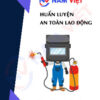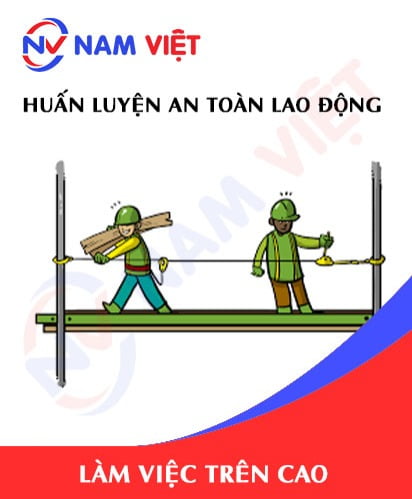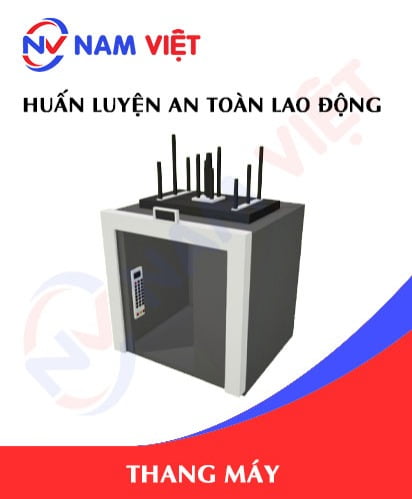Occupational Safety Training for the Interior Construction Trade
99,000 ₫
Note: The above price is calculated for one person and may vary depending on the number of trainees participating in the course and market fluctuations. For more accurate pricing support, please refer to the price list or contact our consultants directly.
The Interior Construction Safety Training course is a program that provides Group 3 occupational safety knowledge. This course will raise trainees’ awareness of how to prevent occupational accidents during work. Accordingly, the occupational safety training content is closely aligned with Article 18 of Decree 44/2016/NĐ-CP.
Table of Contents
Toggle1. Overview of the Interior Construction Profession
a. What is the Interior Construction Profession?
The interior construction profession is a field within the construction and interior decoration industry. It involves designing, producing, installing, and finishing interior elements in living, working, or commercial spaces. Professionals in this field often work to turn design ideas into reality by installing and completing interior components such as tables, chairs, cabinets, windows, doors, flooring, ceilings, and other decorative details.
This work requires knowledge of interior design, materials, construction techniques, and craftsmanship skills. People in this field can include carpenters, painters, glaziers, metalworkers, or other specialists depending on the specific tasks they perform. Interior construction plays a crucial role in creating comfortable, attractive, and functional environments for users.

b. Notable Companies in the Interior Industry
There are many notable companies in the interior industry worldwide, and this list may change over time. Here are some well-known companies you might be familiar with:
- IKEA: IKEA is one of the largest names in the global interior industry. They manufacture and distribute a wide range of affordable furniture and interior decoration products.
- Herman Miller: Herman Miller is a U.S.-based company specializing in high-end office and home furniture, including famous designs like the Eames chairs and George Nelson desks.
- Ashley Furniture Industries: One of the largest furniture manufacturers and retailers in the U.S. and worldwide, with numerous stores and sub-brands.
- Natuzzi: Natuzzi is a renowned Italian company specializing in high-end leather furniture and related products.
- Steelcase: Steelcase produces high-quality office furniture and workspace solutions.
- Roche Bobois: A premium French furniture brand focusing on modern and unique designs.
- BoConcept: Originating from Denmark, BoConcept is famous for its simple, modern furniture designs.
- Williams-Sonoma: A diversified corporation including brands like Pottery Barn and West Elm, specializing in kitchen and home furniture.
- Molteni & C.: An Italian brand specializing in high-end, custom-designed furniture.
- Cassina: An Italian company producing high-end furniture, collaborating with renowned architects like Le Corbusier and Frank Lloyd Wright.
This list cannot cover all companies in the interior industry but reflects the diversity and importance of this sector worldwide.

c. Specific Jobs in the Interior Industry
The interior industry includes many specific jobs, from design and production to construction and sales. Here are some examples:
- Interior Design: Professionals create creative interior designs based on client requirements. They consider space, color, materials, and arrangement of elements to produce models and drawings.
- Furniture Production: Production tasks include working with wood, metal, leather, and other interior components. This can involve carpenters, metalworkers, glaziers, and leather craftsmen.
- Interior Construction: Professionals in interior construction install and finish interior details in spaces, including lighting, doors, flooring, ceilings, and decoration.
- Project Management: Project managers oversee the entire process from design to construction, ensuring timely and budget-compliant completion.
- Interior Decoration: Interior decorators focus on selecting colors, materials, and decorative items, coordinating them to create aesthetically pleasing spaces.
- Material Production: Tasks involve producing materials and accessories for interiors, such as wood, metal, carpets, fabrics, glass, stone, and more.
2. Overview of Occupational Safety Training for the Interior Construction Profession
a. What is Occupational Safety Training for Interior Construction?
- Occupational safety training for interior construction consists of sessions that raise awareness about preventing workplace accidents. Workers directly involved in interior construction belong to Group 3.
- The training helps workers identify and prevent hazards, reducing the risk of workplace accidents.
REGISTER FOR OCCUPATIONAL SAFETY TRAINING
b. Training Duration
Initial Safety Training Duration:
- Total training time is at least 24 hours, including testing.
- 8 hours of theory on safety and occupational hygiene policies and laws
- 8 hours of basic safety and occupational hygiene theory
- 4 hours of specialized training theory
- 2 hours of practical training on specialized content
- 2 hours of theoretical testing at the end of the course
The training center may split the time into multiple sessions depending on worker schedules. Typically, there are 6 sessions over 3 days, assuming continuous availability of employees.
Periodic Safety Training:
- Before the occupational safety card expires, workers wishing to renew must attend a periodic safety training course, with a minimum duration of 50% of the initial training time.
Explanation: total periodic training duration is at least 12 hours, including testing. After completing the course and passing the test, the worker’s occupational safety card will be renewed.
c. Training Content
| No. | TRAINING CONTENT | TRAINING DURATION (HOURS) | |||
| Total | Including | ||||
| Theory | Practice | Test | |||
| I | Policies and laws on occupational safety and hygiene | 8 | 8 | 0 | 0 |
| 1 | Overview of occupational safety and hygiene legal documents. | 6 | 6 | ||
| 2 | Standards and technical regulations on occupational safety and hygiene. | 1 | 1 | ||
| 3 | Specific regulations by state management agencies on safety and hygiene when constructing, expanding, or renovating facilities and handling equipment and materials requiring strict safety standards. | 1 | 1 | ||
| II | Basic knowledge of occupational safety and hygiene | 8 | 8 | 0 | 0 |
| 1 | Basic knowledge of hazards and harmful factors in the workplace. | 4 | 4 | ||
| 2 | Methods to improve working conditions. | 1 | 1 | ||
| 3 | Safety culture in production and business. | 1 | 1 | ||
| 4 | Rights and obligations of employers and employees; safety policies and systems; roles of safety officers. | 1 | 1 | ||
| 5 | Safety rules, signs, personal protective equipment, first aid, and occupational disease prevention skills. | 1 | 1 | ||
| III | Specialized training content | 6 | 4 | 2 | 0 |
| Comprehensive knowledge of machines, equipment, materials with hazardous factors; risk analysis, management, and safe working procedures with equipment and hazardous materials. | 6 | 4 | 2 | ||
| IV | End-of-course safety test | 2 | 2 | 0 | 0 |
| Total | 24 | 22 | 2 | ||
See more training content for all 6 groups
d. Occupational Safety Card
After completing the safety training and passing the test, workers will be issued an occupational safety card (commonly referred to as the Group 3 safety certificate).
The Group 3 card shows details such as name, date of birth, job, and working environment, along with training duration, red stamp, and signature confirming completion.
According to Clause 2 of Article 24, Decree 44/2016/ND-CP, there are 2 cases:
- If the employer and employee have an employment contract, the employer must sign and stamp the card after the employee completes the training and passes the test.
- If the worker is freelance or temporary without a contract, the training unit must sign and stamp the card after the worker completes the training and passes the test.

3. Identifying Hazards in Interior Construction
In interior construction, there are several potential hazards that need to be recognized and managed to ensure the safety of workers and the quality of the project. Below are some key hazards in interior construction:
- Risk of occupational injuries: Jobs in interior construction often require the use of dangerous tools and equipment such as cutting machines, drills, and heavy materials. This can lead to workplace accidents, including cuts, scratches, and injuries from heavy objects. To prevent this, workers need training in occupational safety and the use of protective equipment.
- Risk from chemicals and toxins: During the production and installation of interior works, hazardous chemicals and toxic substances may be used. Care is needed in storing, handling, and disposing of them. Employees should be instructed on safe chemical use and be well-informed about the products.
- Electrical safety risks: Installing electrical equipment and lighting carries the risk of electric shocks or explosions. Careful installation and safety checks of electrical systems are required.
- Structural and construction safety issues: Interior construction may affect the structure and safety of a space. Improper execution can lead to incidents such as structural collapse, glass cracking, or other consequences that could endanger users.
- Fire and explosion risks: Using flammable materials or processes such as welding and metal cutting can create fire and explosion hazards. Compliance with fire safety rules, including proper storage and handling of combustible materials, is essential.

4. Safety Measures for Interior Construction Work
Safety measures for workers in interior construction are crucial to ensure they work in a safe environment and avoid accidents or injuries. Here are some important safety measures:
- Training and guidance: Ensure all workers receive occupational safety training and understand the specific hazards of their job. Training may include the use of personal protective equipment, safety rules, and handling hazardous products and materials.
- Use of personal protective equipment (PPE): Require and provide employees with suitable PPE such as goggles, helmets, masks, gloves, and safety shoes to protect them from specific hazards.
- Inspection and maintenance of equipment: Ensure all tools and equipment are regularly inspected and properly maintained to operate safely.
- Proper waste management: Safely dispose of hazardous or leftover materials in accordance with local and national regulations.
- Inspection of structures and workspace: Ensure the workspace is safe and free from structural hazards. Hazards may include dangerous electricity, toxic floors, and harmful gases.
- Proper use of products and materials: Always follow manufacturer instructions and rules when using interior products and materials. This ensures safe and intended use.
- Electrical safety management: Ensure electrical systems are properly installed and inspected to avoid electric shocks or explosions.
- Work area safety checks: Ensure there are no slip, trip, or other hazards in the workspace, especially when working at heights.
- Fire prevention and firefighting: Provide equipment and instructions for fire prevention and firefighting, and ensure employees know how to use them.
- Building a safety culture: Encourage creating a safety culture within the organization where everyone feels responsible for ensuring workplace safety.
- Periodically conduct work environment monitoring in factories, collect and analyze harmful factors affecting workers, and adjust to reduce hazards to prevent occupational diseases.
5. Benefits of Occupational Safety Training in Interior Construction
An Toàn Nam Việt provides your business with the following benefits after completing occupational safety training courses in accordance with Decree 44/2016/ND-CP regarding occupational safety and hygiene. Companies and enterprises can achieve:
- Workers can identify potential occupational hazards and take preventive measures to avoid accidents.
- Your business can establish risk prevention measures in production, operation, and maintenance processes.
- Reduce costs associated with workplace safety incidents.
- Continuous production helps increase productivity and product quality.
- Ensure compliance with labor safety laws, avoiding legal risks.
- Create credibility and professionalism, thereby enhancing your brand image.
Nam Việt’s training courses are a solution to prevent external factors from affecting individuals, helping them avoid dangers that may lead to injury or even death.
REGISTER FOR OCCUPATIONAL SAFETY TRAINING SERVICE
6. Customer Feedback After Training
An Toàn Nam Việt has many years of experience accompanying enterprises in Vietnam, especially in the southern provinces. This responsibility is highly valuable, which is why our occupational safety training has become increasingly professional. Our motivation for growth comes from positive feedback and suggestions from businesses. Below are some responses from partners we have served.
See more customer interviews after using our services at An Toàn Nam Việt
7. An Toàn Nam Việt’s Occupational Safety Training Capacity
An Toàn Nam Việt is a reputable and quality occupational safety training center in Vietnam. Training sessions are held continuously at production workshops, factories, or construction sites across all 63 provinces.
REGISTER FOR OCCUPATIONAL SAFETY TRAINING SERVICE
Occupational safety training license
- An Toàn Nam Việt has been inspected and certified by the Department of Safety under the Ministry of Labor, War Invalids and Social Affairs, confirming our eligibility for occupational safety and hygiene training. This strengthens our training capability.

Training materials and lectures
- Before being used in occupational safety training courses, materials are reviewed to ensure accuracy and effectiveness.
- Our instructors’ teaching methods follow An Toàn Nam Việt standards, researched by experts in occupational safety and hygiene training to maximize learning effectiveness.
Facilities
- Controlling classroom factors affecting training improves teaching efficiency and learning outcomes.
- Our training facilities provide spacious classrooms meeting standards in area, lighting, and training equipment.
8. Nationwide Reputable Occupational Safety Training Center
At An Toàn Nam Việt, we prioritize professional occupational safety training. Teaching workers to protect themselves contributes to national development.
To ensure effective training, we meticulously prepare everything from tools, equipment, teaching aids, to curriculum, materials, sound, and lighting.
Our instructors are experienced specialists, with research on hazard identification across industries and preventive measures.
Lectures are practical and easy to understand, ensuring comfortable learning and knowledge retention. Training strictly follows Decree 44/2016/ND-CP.
Workers learn preventive measures and how to protect themselves, applying knowledge effectively in real work.
Our training center proudly offers professional and reputable occupational safety training with advantages:
- Competitive training costs with guaranteed quality.
- Flexible training schedule matching company production needs.
- Quick and legal certification procedures.
- Experienced instructors with many years in the field.
- Controlled classrooms enhance teaching efficiency and learning outcomes.
- Lectures tailored to enterprise occupational safety.
- Dedicated and professional service to assist clients quickly and accurately.

9. Additional References for Interior Construction Safety Training Materials
- Occupational Safety Training Materials Set
- Interior Construction Safety Materials
- Occupational Safety Training Test
1 review for Occupational Safety Training for the Interior Construction Trade
No comments yet















caotiensyhung.07081999
Dịch vụ huấn luyện an toàn lao động rất tốt nhé, giảng viên dạy rất sinh động dễ hiểu!